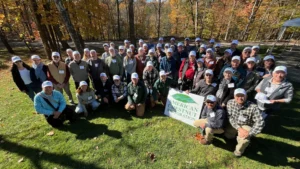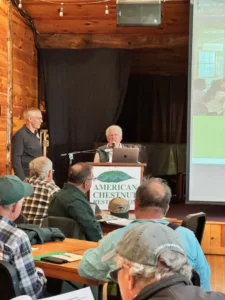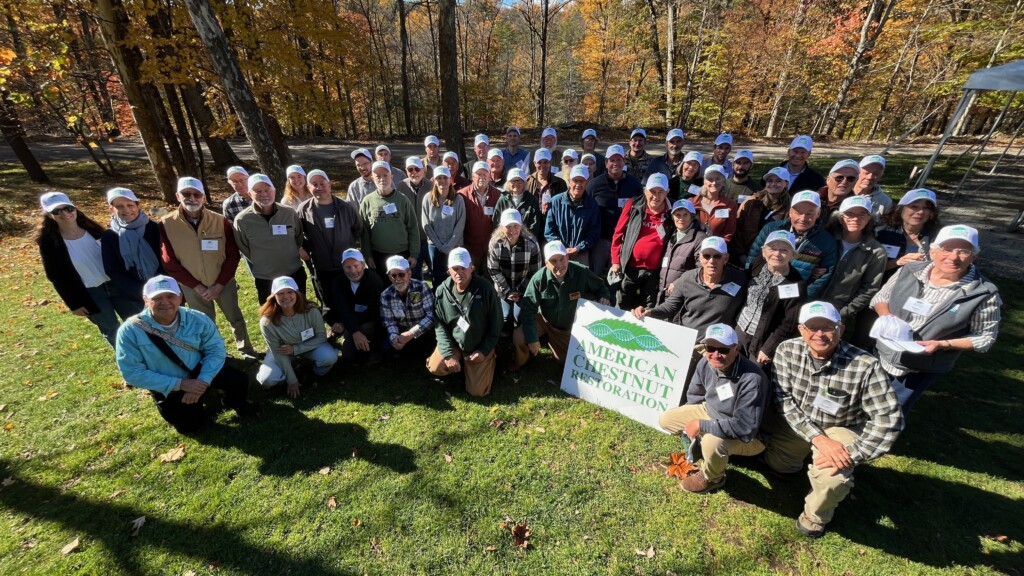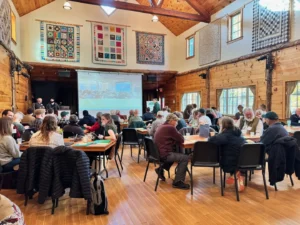The American Chestnut Returns: Restoration Efforts Take Root at the Ashokan Center
For centuries, the American chestnut tree towered over the forests of the eastern United States — a keystone species that nourished wildlife, supported communities, and shaped ecosystems. By the mid-20th century, however, this once-mighty tree had all but disappeared, decimated by a blight that swept across its range and left behind only stumps and memories.
 Now, more than a hundred years later, a revival is underway — and this fall, that revival took center stage at the American Chestnut Restoration, Inc. (ACR) 35th Annual Meeting, held October 24–25, 2025, at The Ashokan Center in Olivebridge, New York. The gathering brought together scientists, conservationists, and forest advocates to share research, strengthen partnerships, and chart the next phase of the species’ return.
Now, more than a hundred years later, a revival is underway — and this fall, that revival took center stage at the American Chestnut Restoration, Inc. (ACR) 35th Annual Meeting, held October 24–25, 2025, at The Ashokan Center in Olivebridge, New York. The gathering brought together scientists, conservationists, and forest advocates to share research, strengthen partnerships, and chart the next phase of the species’ return.
A Shared Commitment to Restoration
ACR is a nonprofit organization leading the charge to restore this iconic species to its native range. Their mission is both scientific and hopeful: to use innovative tools — including biotechnology and traditional breeding — to bring back the American chestnut as a thriving part of our eastern forests.
Hosting ACR’s Annual Meeting at Ashokan was a natural fit. With more than 600 forested acres in the Catskills, the Ashokan Center has long served as a living classroom for ecology, sustainability, and environmental stewardship. Its outdoor education programs connect students and visitors to the natural world through hands-on learning about forest ecosystems, watershed science, and biodiversity.
“It was a joy to gather for ACR’s 35th Annual Meeting at The Ashokan Center,” shared Helen K. Chase, longtime member of ACR. “Jay and Molly joined us for dinner and performed Ashokan Farewell — that iconic tune has such staying power. It was the perfect ending to a weekend focused on legacy, perseverance, and growth.”
The Science of Restoration
Restoring the American chestnut is one of the most ambitious ecological projects of our time. For decades, researchers have explored multiple paths toward recovery — from traditional breeding programs to cutting-edge genetic engineering.
At SUNY College of Environmental Science and Forestry (SUNY-ESF), scientists have developed the Darling 54 line — a genetically engineered tree designed to tolerate the blight that once wiped out billions of its ancestors. As recently highlighted in CNN’s September 2025 coverage, the U.S. Department of Agriculture has concluded its public comment period on the Darling 54 proposal, marking a critical regulatory step that could determine the species’ future in the wild.
The debate surrounding biotechnology in conservation continues, with environmental organizations and scientists weighing both the risks and rewards. What remains constant, however, is the shared vision of a future forest where the American chestnut once again thrives.
Allen Nichols, President of ACR, explained that while earlier hybridization programs attempted to merge Chinese and American chestnut trees, new genetic research revealed that blight resistance in the Chinese chestnut is governed by many genes across all 12 chromosomes — making traditional hybridization an ineffective long-term solution.
“We are not working to cross the pure wild-type American chestnut with Chinese trees,” Nichols emphasized. “Our focus is on supporting ESF’s transgenic program — a promising solution built on decades of genetic and ecological research. The hybrid program looked promising initially, but genetic analysis showed it wouldn’t produce the results we hoped for. The transgenic method gives us a true American chestnut — one that can stand tall again.”
Taking Root at Ashokan
Discussions during the meeting included a new collaborative project: planting a small plot of traditional wild-type American chestnuts on Ashokan’s property — trees that will eventually be paired with future transgenic varieties once they become available. This living plot will serve both research and educational purposes, helping visitors and students understand the chestnut’s ecological importance and its role in forest restoration.
“It will be a fun project,” Chase said, “to determine where to plant and when to plant.”
The initiative aligns beautifully with Ashokan’s broader mission — to connect people with the natural world through  education, history, and the arts. Each year, thousands of students explore these woods, learning about native species, climate, and conservation. The return of the American chestnut will add a powerful new chapter to that story.
education, history, and the arts. Each year, thousands of students explore these woods, learning about native species, climate, and conservation. The return of the American chestnut will add a powerful new chapter to that story.
“Hosting this gathering at Ashokan reinforces our shared belief that learning and action must go hand in hand,” said an Ashokan representative. “Our forests tell the story of resilience — and the return of the chestnut is part of that story.”
Looking Ahead
The work of American Chestnut Restoration, Inc. is a testament to persistence and partnership. Through decades of volunteerism, scientific collaboration, and education, ACR and its allies are helping to heal a wound in the landscape that has lasted for generations.
As this work takes root at the Ashokan Center, it carries with it a vision of restoration — not just of a species, but of the deep connection between people, forests, and the future.
Learn More
Visit these resources to learn more and get involved:
- American Chestnut Restoration, Inc.
- SUNY ESF Chestnut Project
- Modern Farmer: The Great American Chestnut Tree Revival
- CNN Coverage: The Race to Bring Back the American Chestnut (September 2025)


